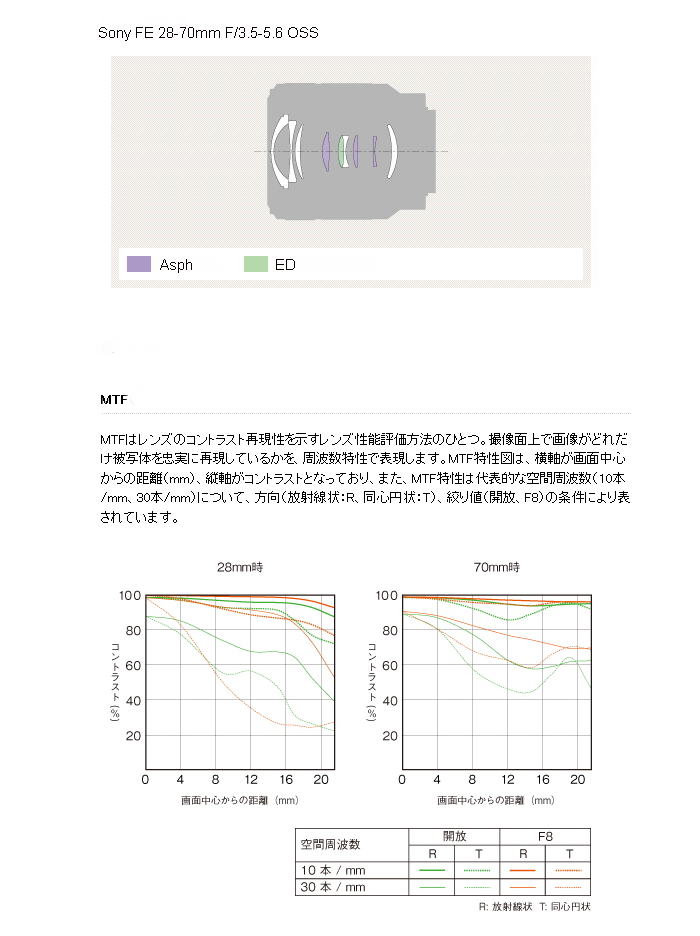The Sony FE 28-70mm F/3.5-5.6 OSS is the first ‘kit’ lens for use with Sony’s full frame ‘E’ mount system. Sony had one ‘kit’ type lens for their full frame ‘a’ system, and that was the Tamron made, Konica Minolta branded, and then Sony branded 28-75mm F/2.8. Minolta had about a half dozen or so kit lenses, the first one was this lens, it was pretty good, and quite small; get it really cheap on ebay right now if you don’t have the $500 bucks to purchase our review lens. Additionally the Sony 24-105mm would be a less expensive alternative that should perform well with the FE system. Don’t forget, you’ll need an adapter for all ‘a’ mount lenses on your FE body; manual focus adapter, or AF adapter, both are made by Sony and work well.
The Sony FE 28-70mm may be considered small and light-weight today, but it’s much larger than other full frame kit type lenses from the past, like the Minolta 35-70/4 mentioned above; not sure why that is. The Sony FE 28-70mm uses an extension barrel for zooming, it is not internal; however, it doesn’t extend much, see pics below. At 28mm, the lens extends about 8mm, and drops down almost flush at 42mm, then extends out about 3mm at 70mm, this zoom action is typical of kit lenses.
Sony included OSS or optical stabilization on this lens, which really helps out in low light conditions. You can turn OSS on or off in the menu system, unfortunately, there is no switch on the outside of the lens.
Fit and finish are good. The lens is made of mostly plastic but uses a metal mount. There is a dust collecting ribbed grip around the focus and zoom rings. Sony claims the use of three aspherical elements in the design, plus an ‘ED’ element. Lens is made in Thailand.
Filter size is 55mm, and is so far the only full frame ‘E’ lens that uses this size, although it’s used also on the smaller APS-C Sony Zeiss 16-70mm. I’d stay away from super expensive Sony filters and cheap ‘general brand’ filters. I’ve had great luck with Tiffen and Hoya; they’re priced appropriately, and are the only brands I use now.
Focusing. This lens auto-focuses quickly and mostly accurately, and has a very quiet linear focusing motor so it can be used for video. The front filter ring doesn’t turn when focusing, so your polarizers and grads will work great. The focusing ring is very easy to turn, and is not damped properly in my opinion, just holding the lens and lightly touching the focus ring can blow the shot, just like this lens.
Oddly, every once in a while this lens makes a weird high pitched noise, I think it’s from the focusing motor. It happens when the zoom is turned back and forth (or even unidirectionally) a few times in quick succession , and when you move the focus ring, it stops; a coincidence or what?
Zoom. Zooming is smooth but not very even, it’s easier to move at wide angle than at the long end. Zoom travel is less than a quarter turn from 28mm to 70mm. This particular lens reads 33-34mm in the exif data when set to exactly 35mm on the barrel; not a big deal, I’m just pointing it out.
In the box is the lens, front and rear caps, and a plastic petal type hood.
Aperture/focal length guide.
| F/3.5 | F/4 | F/4.5 | F/5 | F/5.6 |
| 28-31mm | 32-40mm | 41-52mm | 53-60mm | 61-70mm |
check out the product shots below.
Specifications
| Official lens name and code | Sony FE 28-70mm F/3.5-5.6 OSS SEL2870 |
| Box contents | Front cap, rear cap, plastic petal type hood and user’s manual. |
| Cost | $499 as of 3/14. |
| Build Quality | Good. |
| Additional information | This model is made for Sony ‘E’ mount cameras, and won’t work on ‘A’ mount cameras as of this review. |
| Optical configuration | 9 elements in 8 groups. |
| Angle of view | at 28mm; 75° diagonally, 65° horizontally, and 46° vertically. At 70mm; 29° diagonally, 34° horizontally and 19° vertically. |
| Aperture | 7 blades, curved |
| Coverage for | Sony E mount 24x36mm sensor. When mounted to an APS-C camera, the coverage area is equivalent to 42-105mm in 135 film format. |
| Depth of field and focus scales | nothing. |
| Minimum focus, image plane to subject | About 17.7″ (450mm) at 70mm. 11.8 (300mm) at 28mm. |
| Minimum focus, end of lens barrel to subject | About 13-1/2″ (343mm) from front of lens barrel, no hood. |
| Infinity focus hard stop | No. |
| Length changes when focusing | No. |
| Focus ring turn in AF | No. |
| Filter size | 55mm filter. |
| Filter ring rotates | No. |
| Maximum reproduction ratio | 1:5.3 or 0.19x. |
| Minimum F/stop | F/22-36 |
| Sony Teleconverter compatible | No. |
| Length changes when zooming | Yes |
| Dimensions WxL | 2.85″ x 3.25″ 73mm x 83mm. |
| Maximum extended length | 3.6″ 91mm. |
| Weight | 10.3oz, (292g) bare. |
Optical qualities summary.
| Lens flare/ghosting | overall, good control. |
| Light fall-off | Very good control at all apertures and focal lengths. |
| Color fringing | Average control of lateral type at wide angle, but almost nothing at longer focal lengths. |
| Bokeh | harsh at all focal lengths and apertures. |
| Color | seems about the same as other Sony lenses. |
| Close-up filter | not tested |
| Coma | Very little between 28-50mm. |
| Regular filters | cause no noticeable additional light fall-off, see vignetting below. |
| Filter size | 55mm. not used much in Sony’s ‘E’ world. |
| Distortion | Moderate to strong through most of the zoom range. |
Miscellaneous samples.
This first image is the US stamp from the old site, measuring 0.87″x 1.0″ or 22mm x 25mm. The Sony FE 28-70mm has a reproduction ratio of 1:5.3, which is typical for a zoom lens in this class. The shot is soft at F/5.6, but pretty sharp at F/8.
The next four images show the distortion at each indicated focal length. It has moderate distortion patterns at most settings. Distortion is easy to correct in most post processing software using simple sliders. Don’t worry about this if you shoot jpegs with all the corrections on; or for landscape shots with no straight lines near the image edges.
The last two shots are flare and ghosting samples. This lens handles the sun quite well. The shots below are with the sun inside the frame; this is the worst I could come up with.
Light fall-off.
Light fall-off is well controlled; I tested 28mm, 35mm, and 70mm. There are no problems here.
Bokeh
Bokeh or the character of out of focus highlight blur is harsh at all focal lengths and apertures. It has obvious signs of aspheric element use, as concentric (onion) rings are visible especially towards the wide end if you view your images at their maximum size, at smaller sizes, it can look smooth. As always, if your subject is very close to the lens, and the background is well off in the distance, everything is blurred away, but that’s not ‘bokeh’ it’s simply background blur. I forgot to get the shots at F/3.5 at wide angle, sorry, I see it’s no better after doing a quick test.
28mm resolution samples.
Feel free to download these for your personal inspection. Crop them or toggle between the images to see how sharpness changes between aperture settings.
I see sharp centers and mid-sections at F/4 to F/8, with diffraction Softness showing up at F/11. The sides are a little soft and do not respond much to stopping the aperture down. These images are the same as what I used for in the comparisons with the Sony 24-70mm ZA lens. I did not test F/3.5 at this focal length.
Click button for full size image.
35mm resolution samples.
Our 35mm samples show about the same as the 28mm length. This sides are still a little soft, again, nothing is gained by stopping down past F/8. These are the same images that were used for the comparison.
50mm resolution samples.
The 50mm samples are sharp in the centers and mid-sections from F/4.5 to F/5.6, with a tiny bit of diffraction setting in at F/8, even along the sides. The stuff in the foreground may not be within the depth of field at the widest aperture. This set in not included in the comparison mentioned above.
C lick button for full size image.
70mm resolution samples.
There is not much change as you move from the minimum aperture of F/5.6 to F/11. Not really tack sharp anywhere here, but probably good enough for casual requirements. These are the same images that were used for the comparison.
Click button for full size image.
Conclusion.
The Sony 28-70mm F/3.5-5.6 OSS turned in a decent review. There are some positives to report, and some negatives. First off, I do like the performance at wide angle, it’s pretty good and I think better than some of Sony’s other mid-range zooms, like the 16-50mm and Zeiss 16-80mm. Mid-length performance is decent, nothing special.
There are a couple of disappointments, such as the awful bokeh, but that’s expected of a lens like this. The contrast at the long end is not very good, and makes the lens hard to focus, even with focus peaking. Additionally; I think the lens is larger than it needs to be; why is it not much smaller than the Sony 28-75mm F/2.8 tested here for the ‘a’ mount system?
This Sony 28-70mm performs very well when compared to the much more expensive Sony 24-70mm Ziess lens at wide angle, however, as you move towards the long end, the Ziess has more contrast all around, especially in the mid-sections.
Check out the Sony FE 28-70mm F/3.5-5.6 lens and help support the site! Thanks!















































































